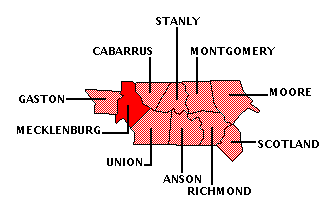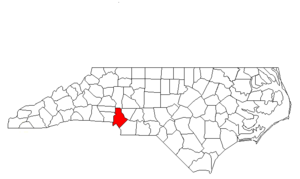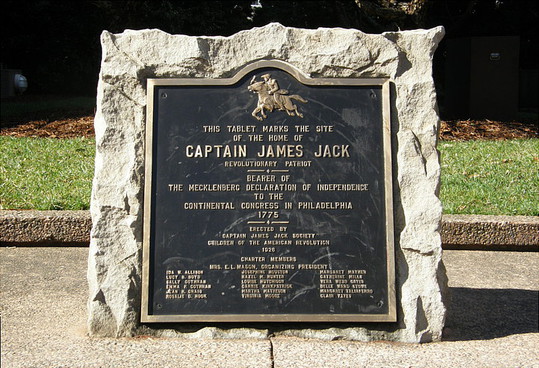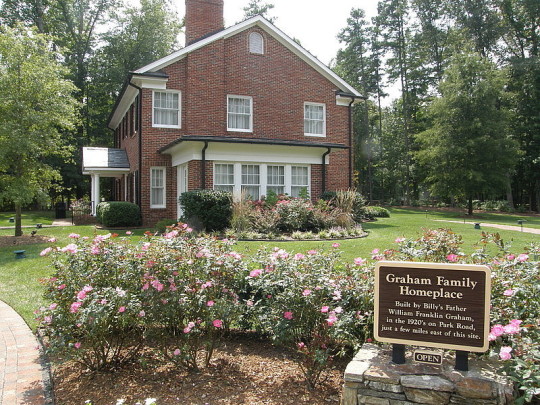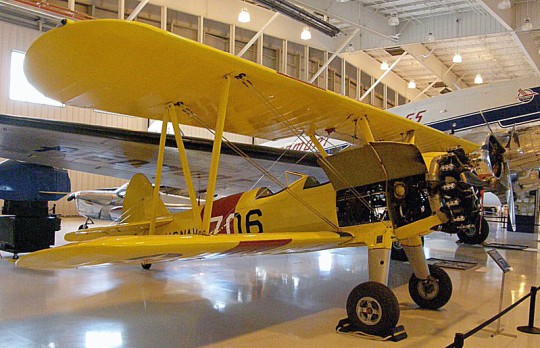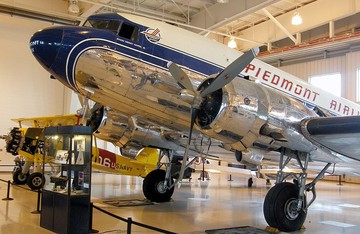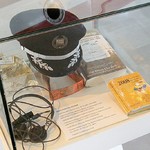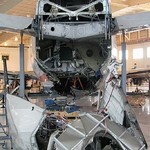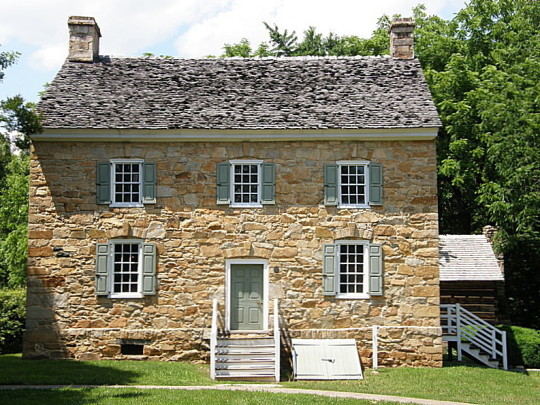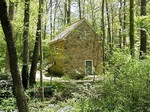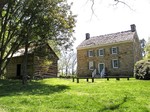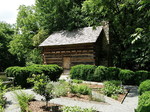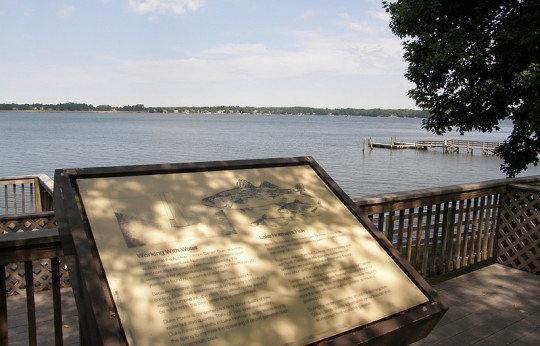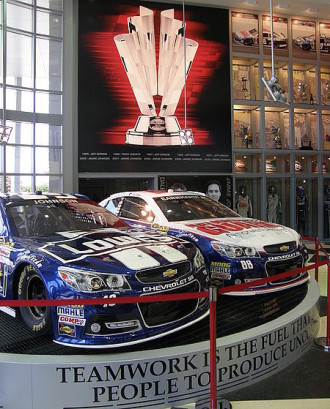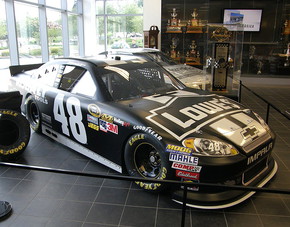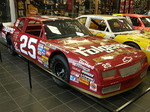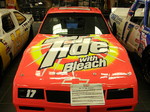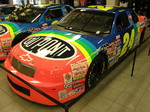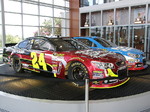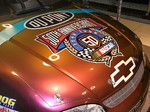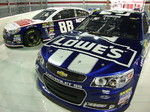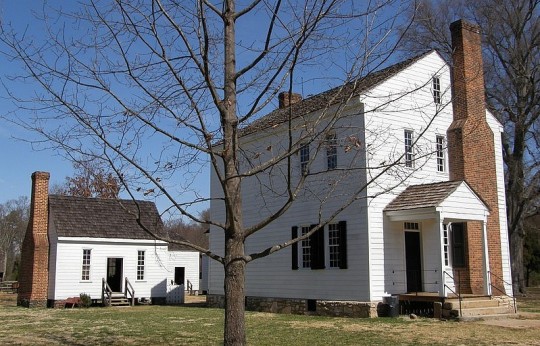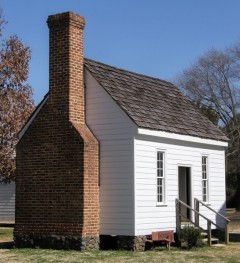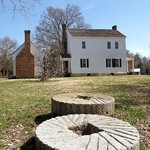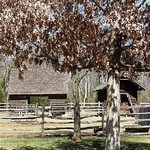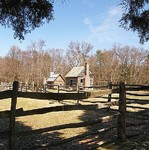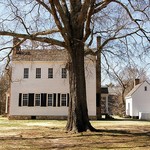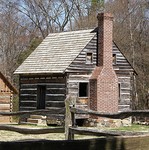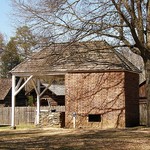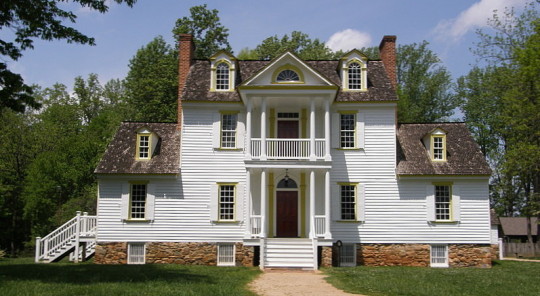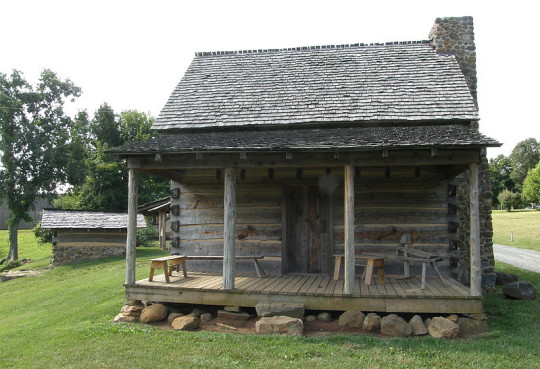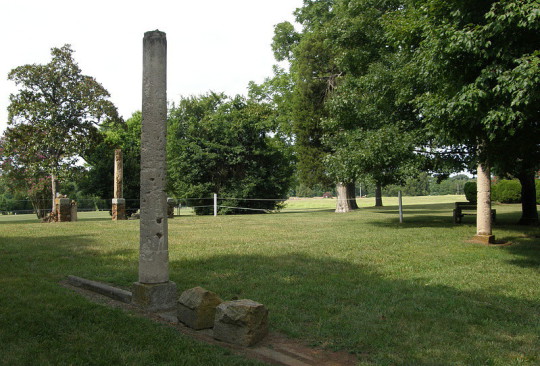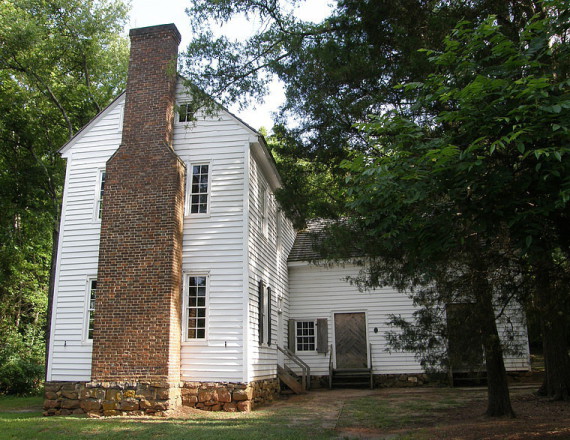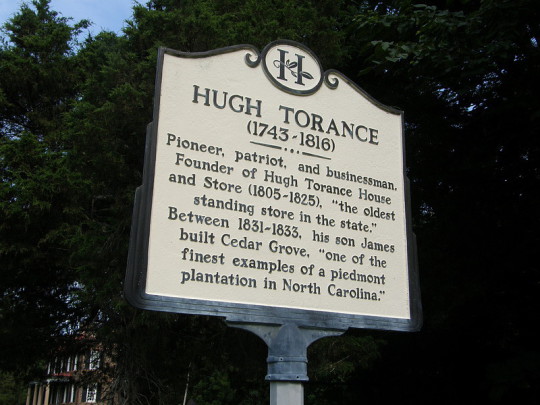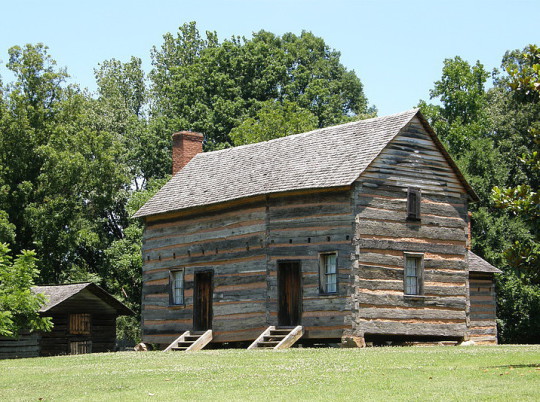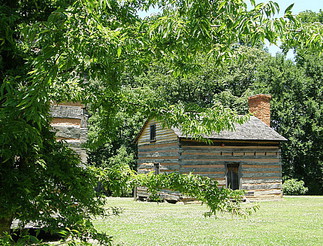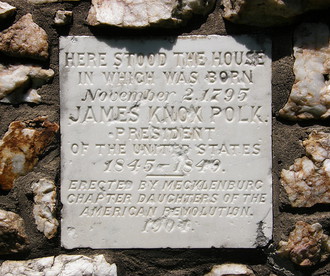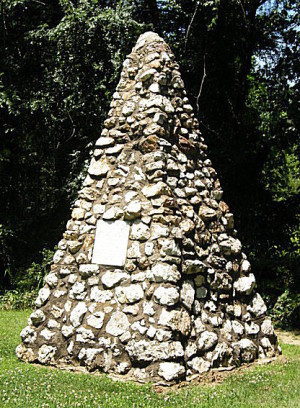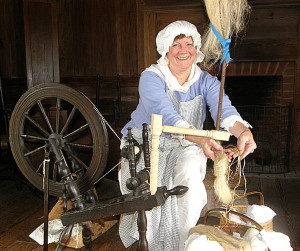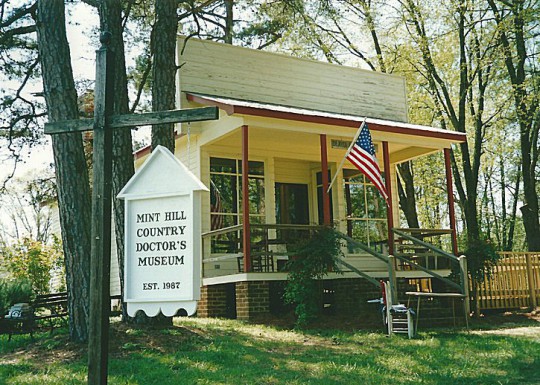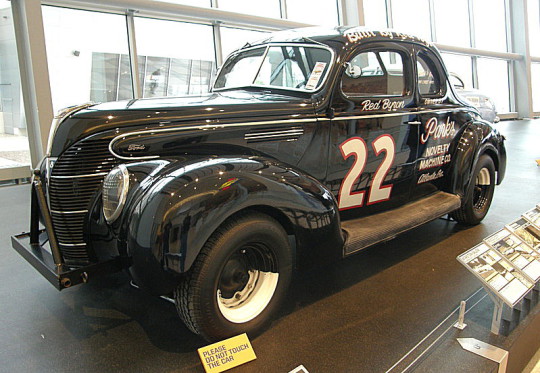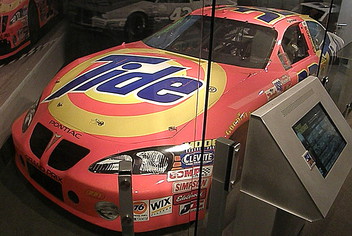MECKLENBURG COUNTY
Scroll down this page or click on specific site name to view features on the following Mecklenburg County attractions/points of interest:
Billy Graham Library, Carolinas Aviation Museum, Charlotte Museum of History and Hezekiah Alexander Homesite, Charlotte Raptor Center, EnergyExplorium, Harvey B. Gantt Center for African-American Arts & Culture, Historic Latta Plantation, Historic Rosedale Plantation, Historic Rural Hill, Hugh Torrance Historic Site, James K. Polk Memorial State Historic Site, Levine Museum of the New South, Mint Hill Country Doctor's Museum, Mint Museum Randolph, Mint Museum Uptown, NASCAR Hall of Fame
Fast facts about Mecklenburg County:
Created in 1762, the county takes its name from the German duchy of Mecklenburg-Strelitz, the home of Charlotte, the wife of King George III.
The county seat is Charlotte, in honor of Queen Charlotte, and is often referred to as “The Queen City.” Other communities include Cornelius, Davidson, Huntersville, Matthews, Mint Hill, and Pineville.
Mecklenburg County’s land area is 526.28 square miles; the population in the 2010 census was 919,628.
It is worth noting that, on May 20, 1775, the citizens of Mecklenburg County were the first to declare their independence from Great Britain; this date is commemorated on the North Carolina state flag and state seal. James K. Polk, the nation’s eleventh president, was born in what is present-day Pineville on November 2, 1795; the James K. Polk Memorial State Historic Site is located near the place of his birth.
Below: Marker in uptown Charlotte honoring the exploits of Captain James Jack, bearer of the Mecklenburg Declaration of Independence to the Second Continental Congress in Philadelphia
Charlotte
Since opening in 2007, the Billy Graham Library has sought both to honor the life of Charlotte native and world-renowned evangelist and to continue his ministry of sharing the Gospel of Jesus Christ. The Library accomplishes these goals via state-of-the-art exhibits, multimedia displays, and personal artifacts. Graham first felt God’s calling to the ministry at age 16, while attending a tent meeting held by evangelist M. F. Ham. After earning a Bachelor’s degree in Theology from Florida Bible College, Graham enrolled at Wheaton College in Illinois, where he met his future wife, Ruth McCue Bell. Graduating from Wheaton with a degree in anthropology, Graham briefly served as a minister at a Baptist church in Western Springs, Illinois before becoming involved with the organization Youths for Christ. Graham became a nationally-known evangelist as a result of the media coverage he received while preaching at a series of revival meetings held in Los Angeles in 1949. Originally scheduled for a three week period, the meetings were held over an additional five weeks. From his preaching to thousands of people in this “canvas cathedral” in Los Angeles, Graham was ultimately able to share God’s word to hundreds of millions across America and around the world. Over the past sixty years, Graham has shared the Good News of Jesus Christ with more than 210 million people in six continents!
Among the many interesting items collected over this lifetime and showcased at the Library are a silver cross worn by Reverend Graham while visiting American troops serving in Korea in 1952; fragments form the Berlin Wall; a ceremonial Native American headdress given to Graham in 1974 when he was named “Natani,” meaning “Warrior of the Great Spirit,” by Indian evangelist Tom Claus; a certificate of honorary knighthood awarded by Queen Elizabeth II; and the Presidential Medal of Freedom, bestowed by President Ronald Reagan in 1983. The site also includes Graham’s boyhood home, carefully restored and filled with family items. Ruth’s Attic is a well-stocked bookshop and gift store named after Graham’s late wife. The Graham Brothers Dairy Bar, a nod to the 300-acre dairy farm the Graham family once operated, serves lunch-menu items, beverages, snacks, and, of course, ice cream treats. Library hours are 9:30-5 Monday through Saturday. Admission is free. 704-401-3200
Charlotte
Dedicated to preserving the aviation history of North and South Carolina, the Carolinas Aviation Museum showcases over two dozen airplanes, helicopters, and “other flying objects.” When the Museum first started up, its collection was displayed in and around a hanger that was itself an item of interest and a rare holdover from Charlotte’s past. The 10,000 square foot hanger built in 1936-37 by the North Carolina Works Progress Administration to serve as the original terminal for Douglas Municipal Airport was the Museum’s first home. When completed in 1937, at a cost of just under $400,000, Douglas Airport consisted of the hanger, an administration building, two 3,000 foot runways, and one 2,500 foot runway. Two daily flights took passengers to Columbia and Charleston. By 1939, the number of daily flights had increased to six, and round-trip airfare to Charleston cost $9.39! One of the planes used for these interstate flights is on display at the Museum.
A centerpiece of the Mu-seum's collection is a DC-3, built in 1942 as a cargo plane but restored in 1987 by Piedmont Airlines and re-fitted for passenger service. Acquired by the Museum for $250,000, the plane is fully operational and is flown to different air shows across the southeast. Another not-able craft is the Douglas D-558-1 Skystreak, built in 1947 for the U. S. Navy and the National Advisory Committee for Aeronautics, NASA’s predecessor. This high-speed research aircraft was designed to gather air/load measurements in free flight at speeds of Mach .75 to .85 from heights ranging from sea-level to 40,000 feet. One of only three such planes built, it flew 82 data-gathering flights between 1948 and 1953. Bob Champine, one of Skystreak’s test pilots, was on hand for the unveiling of the restored aircraft.
The “Miracle on the Hud-son” is now the “Attraction of the Airfield.” On January 15, 2009, USAir’s Flight 1549 took off from New York’s LaGuardia Airport, headed for Charlotte, until an encounter with a flock of geese forced the well-documented emergency landing on the Hudson River. It took three years, but the plane finally landed in the Queen City and is now one of the major attractions at the Carolinas Aviation Museum. The Airbus has been fully reassembled and appears exactly as it did when lifted from the Hudson.
Several of the aircraft on exhibit are warplanes. The Lockheed P-80/TV-1 Shooting Star, America’s first jet fighter, the Republic F-84G Thunder Jet, and the Sikorsky H-03S-1 Dragonfly helicopter all saw action during the Korean War. The Douglas A-4A Skyhawk fighter bomber and two Bell UH-1H Iroquois helicopters, better known as “Hueys,” are from the Vietnam era. Most recently, the A-7E Corsair II, a carrier-based attack bomber, flew 24 missions against Iraqi forces during Desert Storm.
The hardware is fun for adults, but the Museum has a few items especially entertaining for children. The restored cockpit of a Boeing KC-97 Stratotanker gives kids the chance to sit in the pilot’s seat. They can also let their imagination run wild climbing into the seat of a link trainer. A full-scale replica of the “Friendship 7” Mercury capsule that carried John Glenn into orbit around Earth, February 20, 1962, might also pique their interest. The Museum’s location near Charlotte-Douglas Airport adds to the experience – visitors can view these planes of the past while hearing and seeing their present-day counterparts take off and land at Charlotte’s modern, international airport! The Museum is open 10-5, Monday-Saturday; 1-5 Sunday. Admission charged. 704-359-8442
Charlotte
Built in 1774, the Hezekiah Alexander Rock House is the oldest surviving structure in all of Mecklenburg County. An example of Georgian Vernacular architecture, it is atypical to the region. While rock houses similar to this one were common in Pennsylvania and Maryland, two colonies in which Hezekiah and his family had lived prior to coming to Mecklenburg in 1767, they were rarely built in the North Carolina backcountry. Hezekiah Alexander was a well-to-do individual who described himself in later life as a planter; he is known to have had at least 13 slaves on the property in 1795, but virtually nothing is known regarding the details of the plantation. An active member of the community, Alexander served as a county magistrate for more than two decades and was one of 27 men to sign the Mecklenburg Declaration of Independence of May 20, 1775. Most important, perhaps, was his participation in the 5th Provincial Congress, which met in Halifax in November and December of 1776; Alexander served on the committee responsible for writing North Carolina’s first state constitution. Tours include the main house, replica kitchen, reconstructed springhouse, and the American Freedom Bell.
Huntersville
The Carolina Raptor Center is located within the 1,090-acre Latta Plantation Nature Preserve. Dedica-ted to the rehabilitation of injured or orphaned raptors and to the conservation of birds of prey through public education, the Center treats and releases back into the wild hundreds of birds each year. Non-releasable birds take up permanent residence at the Center or travel throughout North and South Carolina as part of the Wild Wings program. At any given time, visitors are likely to see a variety of hawks, owls, vultures, eagles, and falcons. The Center regularly schedules live bird presentations, keeper talks, and behind-the-scenes tours. Year-round hours are 10-5 Monday through Saturday and 12-5 on Sunday. Admission charged. 704-875-6521
Huntersville
Duke's EnergyExplorium is located on the southern end of Lake Norman, in sight of the McGuire Nuclear Station. Interactive exhibits focus on electricity, how nuclear power plants operate, nuclear safety, and more. The facility also includes a mile-long nature trail along the shores of the lake, a butterfly garden, and a large picnic shelter. The EnergyExplorium is open 9-5 Monday through Friday and 12-5 Saturday. Admission is free. 980-875-5600
Lake Norman was created when Duke Energy built Cowans Ford Dam in 1963. Construction on the McGuire Nuclear Station began in 1971, and Unit 1 began its first commercial operation in December, 1981. Unit 2 began commercial operation in March, 1984. McGuire produces approximately 20% of the power Duke Energy generates each year.
Charlotte
Located toward the south end of uptown Charlotte stands the Harvey B. Gantt Center for African-American Arts & Culture. The Center’s permanent collection showcases 58 works by 20 artists gathered over a 50 year period by John and Vivian Hewitt. Included in the collection are pieces by Charlotte-born Romare Beardon; others artists whose works are displayed include Margaret Burroughs, Elizabeth Catlett, Jonathan Green, Jacob Lawrence, and Henry Ossawa Tanner. The Center also hosts numerous temporary exhibitions. Hours are 10-5 Tuesday through Saturday and 1-5 Sunday. Admission charged. The Levine Center for the Arts Access Ticket includes not only the Gantt Center but also the Mint Museum of Art and the Bechtler Museum of Modern Art, both of which are located across the street. 704-547-3700
Charlotte
Hendrick Motorsports had its humble beginnings in 1984, with only five full-time employees working out of a rented, 5,000-square-foot garage. Nearly thirty years later, HMS has positioned itself among the sport’s elites, with three of its drivers – Jeff Gordon, Terry Labonte, and Jimmie Johnson – claiming no less than ten championships in NASCAR’s top series. The Hendrick facilities are still located only a mile from Charlotte Motor Speedway, but the campus now covers 100 acres, has twelve buildings, and employs 500 people. It’s so big that visitors are encouraged to tune their car radios to 92.1 to help them find their way around the site. Guests are encouraged to begin their visit at the combination museum and team store. The latter offers the most recent team-related merchandise, while the museum showcases some of the most storied cars in NASCAR’s history.
Among them are the Kobalt Tools Chevrolet driven by Jimmie Johnson at Darlington Raceway on May 12, 2012 and which earned Hendrick Motor-sports its 200th Cup Series victory; the 1987 Monte Carlo driven to victory by Tim Richmond at Riverside International Speedway on Father’s Day, 1987; the No. 17 “Tide Ride” driven by Darrell Waltrip in 1989 to his first Daytona 500 win; and the No. 24 DuPont Chevrolet Jeff Gordon wheeled for his first-ever Cup Series win at Charlotte Motor Speedway in 1994’s Coca-Cola 500.
After visiting the museum and team store, guests can visit the two race shops. One houses the No. 5 and No. 24 teams, the other the No. 48 and No. 88 teams. Displayed in the lobby of the former are various trophies won by Kasey Kahne and Jeff Gordon, Gordon’s four Cup Championship trophies in 1995, 1997, 1998, and 2001, and a few more memorable cars, including the No. 5 Kellogg’s Chevrolet driven by Terry Labonte. Also on hand is Gordon’s No. 24 DuPont Chevrolet driven in 1998’s All-Star event, celebrating NASCAR’s 50th anniversary and sporting the truly memorable ChromaLusion paint. In the lobby of the race shops for the No. 48 and No. 88 teams are displayed the trophy from Jimmie Johnson’s first Cup win and his five consecutive Sprint Cup championship trophies from 2006 through 2010. Museum and team store hours are 10-5 Monday through Friday and 10-3 Saturday. Admission to the museum and race shops is free. 704-455-0342
Huntersville
Latta Plantation in northern Mecklenburg County is the only remaining Catawba River plantation open to the public. James Latta was of Scots-Irish ancestry and arrived in the fledgling United States of America in 1785. Latta started out as a traveling peddler, purchasing goods in Philadelphia and Charleston and selling them to people living in the Carolina “backcountry.” Latta’s first wife, Elizabeth, died in 1792, leaving him with two sons. He married Jane Knox of Lincoln County in 1796. Three years later, he purchased land in Mecklenburg County and shortly thereafter began construction of his home. A successful cotton planter, Latta’s farm eventually included 742 acres, at one time worked by more than 30 slaves.
The main house is a two-story, Federal-style home featuring a side-hall plan found in Philadelphia town houses of the period. Two rooms take up the first floor; three rooms occupy the second. Exterior features include hand-beaded white clapboard siding and dentil molding in the overhanging frieze; interior features include intricate mantels and finely-detailed staircase. The house is painted in original colors and period pieces, chosen in part upon family records, are as authentic as possible. In addition to the main house, the current 62-acre site includes an original smokehouse, replica kitchen, such dependencies as a stable, corncrib, and well house, and a representative slave cabin. Tours of the main house and kitchen are given by interpreters in period clothing; the rest of the grounds are self-guided. Special events focusing on the Revolutionary and Civil War periods are held frequently. Hours are 10-5 Tuesday-Friday and 12-5 Saturday and Sunday. Admission charged. 704-875-1724 Latta Plantation is a part of the 2,247-acre Latta Plantation Park, which includes the Carolina Raptor Center, the Latta Equestrian Center, and Mountain Island Lake.
Charlotte
Rosedale is the oldest surviving frame house in Charlotte open to the public. Built for merchant, postmaster, and tax collector Archibald Frew in 1815, the large, 13-room Federal-style house was nicknamed “Frew’s Folly” by the neighbors. In the 1830s, the home was occupied by Dr. D. T. Caldwell and his family. In addition to his medical practice, Dr. Caldwell successfully managed a 900-plus acre plantation worked by 20 to 30 slaves. Visitors to Rosedale will almost immediately notice the unusually bright yellow paint used on the exterior trim. Named “Paris Yellow,” the pigment was developed in Paris, France in 1814 and was the first paint in this color available; even painting Rosedale’s comparatively limited trim work was an expensive undertaking. Costly interior features include pine flooring, faux-grained woodwork, and hand-carved detailing. Three rooms still display original wallpaper. An English-style kitchen occupies the basement. Tours of the finely-furnished house, operated by the Historic Rosedale Foundation, interpret 200 years of Charlotte and regional history. In addition to the house, the Rosedale property includes an English garden with boxwood-lined trails and a rose garden. Historic Rosedale is open afternoons Thursday through Sunday, with tours given at 1:30 and 3:00; tours last approximately 90 minutes. Admission charged.
Huntersville
Rural Hill is located on a 265-acre working farm originally owned by Major John Davidson, a signer of the May 20, 1775 Mecklenburg Declaration of Independence and a patriot officer during the American Revolution. The site includes a reproduction log house similar in style to that first lived in by John and his wife, Violet; a smoke house, barn, chicken shed, and granary; and the ruins of the larger plantation home. Also on the premises is the Davidson Schoolhouse, built in 1890 for white children in the community, and the Bethesda Schoolhouse, built circa 1898 for the area’s black children. These buildings are rare survivors of the commonplace, one-room schoolhouses that once dotted the Mecklenburg County landscape. Rural Hill is open 9-4 Monday through Friday and on most Saturdays. Admission charged. Numerous special events are held throughout the year, including “First Footin’,” held on New Year’s Day; the Rural Hill Scottish Festival in mid-April; and the Amazing Maize Maze, open from mid-September through the first weekend in November. 704-875-3113
Huntersville
The Hugh Torance Store, dating to 1805, is believed to be the oldest surviving commercial building in the state. The house to which it is attached is even older, going back to 1779. Torrance and his family were a part of the Hopewell Community in northern Mecklenburg County, and his store provided neighbors with wares gathered from such distant places as Camden, Cheraw, and Charleston in South Carolina, and, to the north, such cities as Roanoke and Philadelphia. Items offered for sale tended to be goods that local families could not produce for themselves: salt, sugar, coffee, tea, and spices; farm tools; household utensils; fine cloth and hats; and accessories for sewing, spinning, and weaving. Most commerce relied upon the barter system. The house and store were refurbished and opened to the public in April, 1989 on a limited schedule. The house is partially furnished with typical period furnishings and provides a good sense of rural life in Mecklenburg County at the turn of the 19th century; the store shelves are stocked with a representative sampling of items Hugh Torrance and his son James likely would have sold. The house and store are located at 8231 Gilead Road. The site is open on a limited schedule seasonally. 704-875-3271
Pineville
One of many impressive statues on the state capitol grounds in Raleigh is that honoring the three US presidents North Carolina gave the nation: Andrew Jackson, James K. Polk, and Andrew Johnson. A question exists as to whether Jackson was actually born in North or South Carolina, and both states claim him as a native son. The cabin in which Jackson was born no longer stands. The small frame house in which Johnson was born still exists in Raleigh; moved from its original site years ago, it now stands in the capital city's Mordecai Park. Only the boyhood home of Polk, in Pineville, is preserved as a state historic site.
Our country's eleventh president was born in rural Mecklenburg County November 2, 1795, the first of ten children born to Samuel and Jane Knox Polk. Although the Polks were a successful middle-class farming family, they nevertheless moved to Tennessee when James was about eleven years old in search of more land and greater prosperity. Throughout his youth, Polk was frail and sickly, so much so that his father decided to have him learn to read and write at home rather than at a formal school. When James was sixteen, it was finally diagnosed that his poor health was the result of gallstones. Following a successful operation, James quickly gained strength and stamina, and at age seventeen entered an academy which prepared him for enrollment as a sophomore at the University of North Carolina. In 1818, Polk graduated first in his class.
Polk was studying law in Nashville, Tennessee when he was introduced to Andrew Jackson, a man who would greatly influence James' political ideology. It was also while in Nashville that he became reacquainted with Sarah Chil-dress, the sister of a former schoolmate. Sarah stoked his political ambitions and encour-aged James to enter the race for the Tennessee legislature in 1823. His election was but the first step on what proved to be a life-long career in politics. In 1825, Polk was elected to the US House of Representatives, where he served for fourteen years, including a term as speaker of the House. He then won the Tennessee governorship in 1839.
Polk was a Jacksonian Democrat, and he hoped to be his party's nominee for Vice President in 1840. It was not to be. In 1841, Polk failed to win re-election as governor of Tennessee and lost the gubernatorial race again in 1843. He seemed therefore an unlikely candidate to receive the Democratic Party's nomination for President in 1844. Former President Martin Van Buren was the early favorite, but when the Democrats still had not chosen a candidate by their seventh ballot, Polk suddenly became a viable "compromise" candidate for the disparate wings of the party. Winning the nomination on the ninth ballot, Polk challenged the Whig Party's Henry Clay, a well-known senator who had earned the nickname "The Great Compromiser." It was the Democrats' compromise candidate, however, who won the Presidency by an electoral vote of 170-105; the popular vote was much closer, 1,339,494 to 1,300,004. Polk's victory made him the nation's first "dark horse" president.
"Fifty-four forty or fight" had been one of Polk's campaign slogans, but as President he successfully - and peacefully - negotiated with Great Britain the northern boundary for the Oregon territory, setting it at the 49th parallel. Polk's platform also endorsed the admission of Texas as the 27th state, which took place shortly after Polk took office. Polk sent troops to patrol the disputed border territory between Texas and Mexico, an action which all but insured that hostilities with Mexico would follow. Opponents dubbed the two-year conflict as "Mr. Polk's War," but the treaty which ended the war in 1848 ceded to the United States considerable land, including the New Mexico territory and California. This earned for Polk the distinction of being the most expansionistic of all Presidents. For the first time, the United States and her territories stretched from the Atlantic to the Pacific and helped to fulfill what many of Polk's contemporaries considered America's "Manifest Destiny." Iowa and Wisconsin joined the Union during Polk's term, and the territories of Oregon and Minnesota were formed. President Polk also fulfilled two other major campaign promises, to reduce the tariff and to re-establish an independent treasury. The US Naval Academy was also established during Polk's administration.
James Polk had intended from the beginning to be a one-term President, and he and Sarah left Washington in March, 1849 to return to their home in Nashville, Tennessee. Three months later, Polk was stricken with cholera and died. Many felt that Polk had given too much of himself while in office and had worked himself to exhaustion, making him more susceptible to an illness that he otherwise might have been able to overcome. He was buried on the grounds of the Tennessee state capitol in Nashville.
The first efforts to memorialize the birthplace of President James Polk were undertaken by the Mecklenburg Chapter of the Daughters of the American Revolution. In 1904, a rough stone monument was dedicated near the foundation of what was then thought to have been the farmhouse in which Polk was born. Approximately 400 citizens attended the unveiling of the DAR monument to President Polk September 26, 1904. The land was still privately owned, however, and in the early 1950s the site was overgrown. James A. Stenhouse, a Charlotte architect and historian, is largely credited with spearheading a drive to preserve the site. Because of anticipated suburban development in the Pineville area, land values escalated dramatically, so several years elapsed before the state was finally able to purchase twenty-one acres, making the landmark a state historic site in 1964.
Research in that year indicated that US Highway 521 probably passed over the actual location of the Polks' farmhouse, so an area some 200 yards northeast was chosen for the site of the reconstructed farm. For the main house, two area log houses dating to the early 1800s were dismantled and reassembled. The final appearance of the house is based in part on speculation and in part upon a small sketch of the house drawn by former Governor David L. Swain in 1851; Swain, a student of history, had visited the home in 1849. The detached kitchen and the barn were also structures moved to the site from neighboring communities. Construction of the visitor center began in November, 1967 and was completed the following spring. Appropriately, First Lady Claudia "Lady Bird" Johnson dedicated the site December 6, 1968.
Docents give visitors to the Polk Memorial guided tours of the main house and kitchen. The 1904 stone pyramid monument erected by the DAR was moved from its original location and stands a short walk from the main house. The visitor center offers a 22-minute film which uses the 1844 Presidential campaign's oft- asked question "Who Is Polk?" as its theme. The museum likewise attempts to answer the question "Who Is Polk?" by providing a look at the things that shaped his outlook. Included are exhibits on early 1800 farm life in the North Carolina piedmont; the cultural clash of agrarian society with the industrial revolution during the "Spirited Age;" Polk's political career and the Presidential campaign of 1844; and the Mexican War. Of particular note among the many artifacts on display is the dress chapeau worn by General Santa Anna, a trophy of that war taken by the president’s younger brother, Major William H. Polk. The James K. Polk Memorial is located on US Highway 521, approximately one mile south of Pineville. Hours are 9-5 Tuesday-Saturday. Admission is free.
Charlotte
“Cotton Fields to Skyscrapers” is the name of the facility’s centerpiece exhibition, and it gives a good indication as to what the Levine Museum of the New South is all about. The Museum focuses on the history of Charlotte and the region beginning with Reconstruction in 1865 and continuing through the present. 1,000-plus artifacts, photographs, videos, and oral histories engage and educate visitors about 150 years of dramatic social, cultural, and economic changes. Hours are 10-5 Monday through Saturday and 12-5 Sunday. Closed Thanksgiving, Christmas, New Year’s Day, and July 4. Admission charged. 704-333-1887
Mint Hill
The Mint Hill Historical Society was formed in 1985 to preserve the history of the small town of Mint Hill. Their first restoration project was the Mint Hill Country Doctor's Museum. Over the next 25 years, the site would evolve into the Carl J. McEwen Historic Village, which is now home to the Ferguson store, Ashcraft school-house, and the Assay office. Visitors to this charming site can also view the meat curing building, hen house, and blacksmith’s shop. The site’s most popular annual event is the Christmas tea, which brings in hundreds of attendees from the area and beyond. During the holiday season, the Assay office becomes home to the Village Christmas Shoppe where seasonal decorations and gifts may be purchased.
During the school year, hundreds of area school children step back into the days of the early 20th century to see what their school day may have been like in rural Mecklenburg County. Various events take place on the grounds during the year, such as Salute to Veterans and historical reenactments. The site is also part of the Discover Mint Hill event held every spring. The Mint Hill Farmers Market, located on the grounds of the Historic Village, is a place to purchase locally grown produce and plants, as well as a place to meet friends and listen to the live music of local musicians. Museum buildings are open and provide a friendly, down-home feel to the shopping experience.
The Mint Hill Historical Society Office is open Tuesday through Saturday from 10 am until 2 pm. Tours of the Carl J. McEwen Historic Village are available by appointment. Contact the office at (704) 573-0726 or info@MintHillHistory.com. Admission to the village is $5.00 for adults 19-60, $4.00 for children 6-18 and seniors 60 and over, and free for children age five and under.
MINT HILL COUNTRY DOCTOR'S MUSEUM
Text for the Mint Hill Country Doctor’s Museum courtesy of Lisa Jillani.
Charlotte
The Mint Museum’s Randolph Road location opened in1936 in a building that originally served as a branch of the United States Mint from 1837 to 1861, giving the Museum both a space and a name. The Mint Museum has the distinction of being North Carolina’s first state art museum. Today, the facility on Randolph Road stands in a pleasantly-landscaped setting and its collections include ceramics, decorative arts, fashion, and European and African art. Hours are 11-9 Wednesday, 11-6 Thursday through Saturday, and 1-5 Sunday. Admission charged. 704-337-2000
Charlotte
The Mint Museum’s spacious 5-story, 145,000-square-foot facility in uptown Charlotte features three permanent collections (American art, modern and contemporary, and craft and design) plus several rotating exhibitions. Hours are 11-9 Wednesday, 11-6 Thursday through Saturday, and 1-5 Sunday. Admission charged. 704-337-2000
Charlotte
The National Association for Stock Car Auto Racing, Inc [NASCAR] dropped the green flag on its Hall of Fame in uptown Charlotte in 2010, and everything about the place is new, exciting, and techno-savvy. Thus far, twenty of the most famous and influential individuals in the 65-year history of the sport have been inducted, with the five members of the 2014 class already announced. Bill France, Sr., Bill France, Jr., Richard Petty, Junior Johnson, and Dale Earnhardt, Sr. were the five inductees in the inaugural class of 2010, and the likes of David Pearson, Bobby Allison, Lee Petty, Cale Yarborough, Darrell Waltrip, and Rusty Wallace have since been added to the list. Along with exhibits and artifacts relating to these honorees, the Hall has many activities and displays to engage and entertain visitors.
The High Octane Theater provides a quick overview of NASCAR’s origins and devel-opment and provides an ap-propriate introduction to the Hall. Representative cars from the sport’s earliest beginnings up through to-day’s latest models are dramatically displayed on “Glory Road,” the Hall’s banked ramp that features eighteen historic race cars and provides information about forty current and former tracks. Elsewhere in the Hall, guests can view highlights of some of the sport’s most exciting finishes, test their speed at changing tires, provide the audio for the final laps of a race on radio, and get behind the wheel of a full-sized racing simulator. The Hall is open 10-6 daily. Admission charged.
Mecklenburg County is bordered by CABARRUS, GASTON, IREDELL (Region Eight), LINCOLN (Region Eight), and UNION counties.
Return to REGION SEVEN HOME PAGE.
Return to GEOGRAPHIC REGIONS HOME PAGE.

